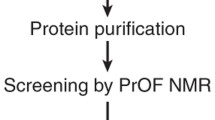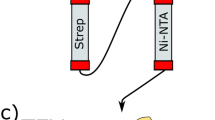Abstract
Epitope mapping is an important tool for the development of monoclonal antibodies, mAbs, as therapeutic drugs. Recently, a class of therapeutic mAb alternatives, adnectins, has been developed as targeted biologics. They are derived from the 10th type III domain of human fibronectin (10Fn3). A common approach to map the epitope binding of these therapeutic proteins to their binding partners is X-ray crystallography. Although the crystal structure is known for Adnectin 1 binding to human epidermal growth factor receptor (EGFR), we seek to determine complementary binding in solution and to test the efficacy of footprinting for this purpose. As a relatively new tool in structural biology and complementary to X-ray crystallography, protein footprinting coupled with mass spectrometry is promising for protein–protein interaction studies. We report here the use of fast photochemical oxidation of proteins (FPOP) coupled with MS to map the epitope of EGFR-Adnectin 1 at both the peptide and amino-acid residue levels. The data correlate well with the previously determined epitopes from the crystal structure and are consistent with HDX MS data, which are presented in an accompanying paper. The FPOP-determined binding interface involves various amino-acid and peptide regions near the N terminus of EGFR. The outcome adds credibility to oxidative labeling by FPOP for epitope mapping and motivates more applications in the therapeutic protein area as a stand-alone method or in conjunction with X-ray crystallography, NMR, site-directed mutagenesis, and other orthogonal methods.

ᅟ





Similar content being viewed by others

References
Xu, L., Aha, P., Gu, K., Kuimelis, R.G., Kurz, M., Lam, T., Lim, A.C., Liu, H., Lohse, P.A., Sun, L., Weng, S., Wagner, R.W., Lipovsek, D.: Directed evolution of high-affinity antibody mimics using mrna display. Chem. Biol. 9, 933–942 (2002)
Hackel, B.J., Kapila, A., Wittrup, K.D.: Picomolar affinity fibronectin domains engineered utilizing loop length diversity, recursive mutagenesis, and loop shuffling. J. Mol. Biol. 381, 1238–1252 (2008)
Wojcik, J., Hantschel, O., Grebien, F., Kaupe, I., Bennett, K.L., Barkinge, J., Jones, R.B., Koide, A., Superti-Furga, G., Koide, S.: A potent and highly specific fn3 monobody inhibitor of the abl sh2 domain. Nat. Struct. Mol. Biol. 17, 519–527 (2010)
Koide, A., Bailey, C.W., Huang, X., Koide, S.: The fibronectin type iii domain as a scaffold for novel binding proteins. J. Mol. Biol. 284, 1141–1151 (1998)
Koide, A., Abbatiello, S., Rothgery, L., Koide, S.: Probing protein conformational changes in living cells by using designer binding proteins: application to the estrogen receptor. Proc. Natl. Acad. Sci. U.S.A. 99, 1253–1258 (2002)
Karatan, E., Merguerian, M., Han, Z., Scholle, M.D., Koide, S., Kay, B.K.: Molecular recognition properties of fn3 monobodies that bind the src sh3 domain. Chem. Biol. 11, 835–844 (2004)
Main, A.L., Harvey, T.S., Baron, M., Boyd, J., Campbell, I.D.: The three-dimensional structure of the 10th type III module of fibronectin: an insight into RGD-mediated interactions. Cell 71, 671–678 (1992)
Dickinson, C.D., Veerapandian, B., Dai, X.P., Hamlin, R.C., Xuong, N.H., Ruoslahti, E., Ely, K.R.: Crystal structure of the 10th type III cell adhesion module of human fibronectin. J. Mol. Biol. 236, 1079–1092 (1994)
Leahy, D.J., Erickson, H.P., Aukhil, I., Joshi, P., Hendrickson, W.A.: Crystallization of a fragment of human fibronectin: introduction of methionine by site-directed mutagenesis to allow phasing via selenomethionine. Proteins 19, 48–54 (1994)
Leahy, D.J., Aukhil, I., Erickson, H.P.: 2.0 Angstrom crystal structure of a four-domain segment of human fibronectin encompassing the rgd loop and synergy region. Cell 84, 155–164 (1996)
Mamluk, R., Carvajal, I.M., Morse, B.A., Wong, H., Abramowitz, J., Aslanian, S., Lim, A.C., Gokemeijer, J., Storek, M.J., Lee, J., Gosselin, M., Wright, M.C., Camphausen, R.T., Wang, J., Chen, Y., Miller, K., Sanders, K., Short, S., Sperinde, J., Prasad, G., Williams, S., Kerbel, R., Ebos, J., Mutsaers, A., Mendlein, J.D., Harris, A.S., Furfine, E.S.: Anti-tumor effect of ct-322 as an adnectin inhibitor of vascular endothelial growth factor receptor-2. mAbs 2, 199–208 (2010)
Bloom, L., Calabro, V.: Fn3: a new protein scaffold reaches the clinic. Drug Discov. Today 14, 949–955 (2009)
Molckovsky, A., Siu, L.L.: First-in-class, first-in-human phase I results of targeted agents: highlights of the 2008 American Society of Clinical Oncology Meeting. J. Hematol. Oncol. 1, 20 (2008)
Tolcher, A.W., Sweeney, C.J., Papadopoulos, K., Patnaik, A., Chiorean, E.G., Mita, A.C., Sankhala, K., Furfine, E., Gokemeijer, J., Iacono, L., Eaton, C., Silver, B.A., Mita, M.: Phase I and pharmacokinetic study of CT-322 (BMS-844203), a targeted adnectin inhibitor of VEGFR-2 based on a domain of human fibronectin. Clin. Cancer Res. 17, 363–371 (2011)
Janmaat, M.L., Giaccone, G.: The epidermal growth factor receptor pathway and its inhibition as anticancer therapy. Drugs Today 39(Suppl C), 61–80 (2003)
Yarden, Y., Sliwkowski, M.X.: Untangling the ErbB signaling network. Nat. Rev. Mol. Cell Biol. 2, 127–137 (2001)
Zhang, H., Shen, W., Rempel, D., Monsey, J., Vidavsky, I., Gross, M.L., Bose, R.: Carboxyl-group footprinting maps the dimerization interface and phosphorylation-induced conformational changes of a membrane-associated tyrosine kinase. Mol. Cell. Proteom. 10, M110 005678 (2011)
Schlessinger, J.: Cell signaling by receptor tyrosine kinases. Cell 103, 211–225 (2000)
Masui, H., Kawamoto, T., Sato, J.D., Wolf, B., Sato, G., Mendelsohn, J.: Growth inhibition of human tumor cells in athymic mice by anti-epidermal growth factor receptor monoclonal antibodies. Cancer Res. 44, 1002–1007 (1984)
Sato, J.D., Kawamoto, T., Le, A.D., Mendelsohn, J., Polikoff, J., Sato, G.H.: Biological effects in vitro of monoclonal antibodies to human epidermal growth factor receptors. Mol. Biol. Med. 1, 511–529 (1983)
Flynn, J.F., Wong, C., Wu, J.M.: Anti-EGFR therapy: mechanism and advances in clinical efficacy in breast cancer. J. Oncol (2009). doi:10.1155/2009/526963
Ramamurthy, V., Krystek Jr., S.R., Bush, A., Wei, A., Emanuel, S.L., Das Gupta, R., Janjua, A., Cheng, L., Murdock, M., Abramczyk, B., Cohen, D., Lin, Z., Morin, P., Davis, J.H., Dabritz, M., McLaughlin, D.C., Russo, K.A., Chao, G., Wright, M.C., Jenny, V.A., Engle, L.J., Furfine, E., Sheriff, S.: Structures of adnectin/protein complexes reveal an expanded binding footprint. Structure 20, 259–269 (2012)
Emanuel, S.L., Engle, L.J., Chao, G., Zhu, R.R., Cao, C., Lin, Z., Yamniuk, A.P., Hosbach, J., Brown, J., Fitzpatrick, E., Gokemeijer, J., Morin, P., Morse, B.A., Carvajal, I.M., Fabrizio, D., Wright, M.C., Das Gupta, R., Gosselin, M., Cataldo, D., Ryseck, R.P., Doyle, M.L., Wong, T.W., Camphausen, R.T., Cload, S.T., Marsh, H.N., Gottardis, M.M., Furfine, E.S.: A fibronectin scaffold approach to bispecific inhibitors of epidermal growth factor receptor and insulin-like growth factor-I receptor. mAbs 3, 38–48 (2011)
Carugo, O., Argos, P.: Protein-protein crystal-packing contacts. Protein Sci. 6, 2261–2263 (1997)
Xu, Q., Canutescu, A.A., Wang, G., Shapovalov, M., Obradovic, Z., Dunbrack Jr., R.L.: Statistical analysis of interface similarity in crystals of homologous proteins. J. Mol. Biol. 381, 487–507 (2008)
Benjamin, D.C., Berzofsky, J.A., East, I.J., Gurd, F.R., Hannum, C., Leach, S.J., Margoliash, E., Michael, J.G., Miller, A., Prager, E.M., Reichlin, M., Sercarz, E. E., Smith-Gill, S. J., Todd, P. E., and Wilson, A. C.: The antigenic structure of proteins: a reappraisal. Annu. Rev. Immunol. 2, 67–101 (1984)
Scott, J.K., Smith, G.P.: Searching for peptide ligands with an epitope library. Science 249, 386–390 (1990)
Geysen, H.M., Meloen, R.H., Barteling, S.J.: Use of peptide synthesis to probe viral antigens for epitopes to a resolution of a single amino acid. Proc. Natl. Acad. Sci. U.S.A. 81, 3998–4002 (1984)
Jemmerson, R., Paterson, Y.: Mapping epitopes on a protein antigen by the proteolysis of antigen-antibody complexes. Science 232, 1001–1004 (1986)
Yamada, N., Suzuki, E., Hirayama, K.: Identification of the interface of a large protein-protein complex using H/D exchange and Fourier transform ion cyclotron resonance mass spectrometry. Rapid Commun. Mass Spectrom. 16, 293–299 (2002)
Baerga-Ortiz, A., Hughes, C.A., Mandell, J.G., Komives, E.A.: Epitope mapping of a monoclonal antibody against human thrombin by H/D exchange mass spectrometry reveals selection of a diverse sequence in a highly conserved protein. Protein Sci. 11, 1300–1308 (2002)
Lu, J., Witcher, D.R., White, M.A., Wang, X., Huang, L., Rathnachalam, R., Beals, J.M., Kuhstoss, S.: Il-1beta epitope mapping using site-directed mutagenesis and hydrogen-deuterium exchange mass spectrometry analysis. Biochemistry 44, 11106–11114 (2005)
Coales, S.J., Tuske, S.J., Tomasso, J.C., Hamuro, Y.: Epitope mapping by amide hydrogen/deuterium exchange coupled with immobilization of antibody, on-line proteolysis, liquid chromatography and mass spectrometry. Rapid Commun. Mass Spectrom. 23, 639–647 (2009)
Zhang, Q., Willison, L.N., Tripathi, P., Sathe, S.K., Roux, K.H., Emmett, M.R., Blakney, G.T., Zhang, H.M., Marshall, A.G.: Epitope mapping of a 95 kDa antigen in complex with antibody by solution-phase amide backbone hydrogen/deuterium exchange monitored by Fourier transform ion cyclotron resonance mass spectrometry. Anal. Chem. 83, 7129–7136 (2011)
Pandit, D., Tuske, S.J., Coales, S.J., E, S.Y., Liu, A., Lee, J.E., Morrow, J.A., Nemeth, J.F., Hamuro, Y.: Mapping of discontinuous conformational epitopes by amide hydrogen/deuterium exchange mass spectrometry and computational docking. J. Mol. Recognit. 25, 114–124 (2012)
Jensen, P.F., Jorgensen, T.J., Koefoed, K., Nygaard, F., Sen, J.W.: Affinity capture of biotinylated proteins at acidic conditions to facilitate hydrogen/deuterium exchange mass spectrometry analysis of multimeric protein complexes. Anal. Chem. 85, 7052–7059 (2013)
Takamoto, K., Chance, M.R.: Radiolytic protein footprinting with mass spectrometry to probe the structure of macromolecular complexes. Annu. Rev. Biophys. Biomol. Struct. 35, 251–276 (2006)
Pan, Y., Brown, L., Konermann, L.: Mapping the structure of an integral membrane protein under semi-denaturing conditions by laser-induced oxidative labeling and mass spectrometry. J. Mol. Biol. 394, 968–981 (2009)
Pan, Y., Stocks, B.B., Brown, L., Konermann, L.: Structural characterization of an integral membrane protein in its natural lipid environment by oxidative methionine labeling and mass spectrometry. Anal. Chem. 81, 28–35 (2009)
Jones, L.M., Sperry, J.B., Caroll, J.A., Gross, M.L.: Fast photochemical oxidation of proteins for epitope mapping. Anal. Chem. 83, 7657–7661 (2011)
Maleknia, S.D., Brenowitz, M., Chance, M.R.: Millisecond radiolytic modification of peptides by synchrotron X-rays identified by mass spectrometry. Anal. Chem. 71, 3965–3973 (1999)
Sharp, J.S., Becker, J.M., Hettich, R.L.: Analysis of protein solvent accessible surfaces by photochemical oxidation and mass spectrometry. Anal. Chem. 76, 672–683 (2004)
Aye, T.T., Low, T.Y., Sze, S.K.: Nanosecond laser-induced photochemical oxidation method for protein surface mapping with mass spectrometry. Anal. Chem. 77, 5814–5822 (2005)
Hambly, D.M., Gross, M.L.: Laser flash photolysis of hydrogen peroxide to oxidize protein solvent-accessible residues on the microsecond timescale. J. Am. Soc. Mass Spectrom. 16, 2057–2063 (2005)
Gau, B.C., Sharp, J.S., Rempel, D.L., Gross, M.L.: Fast photochemical oxidation of protein footprints faster than protein unfolding. Anal. Chem. 81, 6563–6571 (2009)
Hambly, D., Gross, M.: Laser flash photochemical oxidation to locate heme binding and conformational changes in myroglobin. Int. J. Mass Spectrom. 259, 124–129 (2007)
Gau, B.C., Chen, H., Zhang, Y., Gross, M.L.: Sulfate radical anion as a new reagent for fast photochemical oxidation of proteins. Anal. Chem. 82, 7821–7827 (2010)
Xu, G., Chance, M.R.: Radiolytic modification of acidic amino acid residues in peptides: probes for examining protein-protein interactions. Anal. Chem. 76, 1213–1221 (2004)
Xu, G., Chance, M.R.: Hydroxyl radical-mediated modification of proteins as probes for structural proteomics. Chem. Rev. 107, 3514–3543 (2007)
Zhu, W., Smith, J.W., Huang, C.M.: Mass spectrometry-based label-free quantitative proteomics. J. Biomed. Biotechnol. 2010, 840518 (2010)
Zhang, H., Gau, B.C., Jones, L.M., Vidavsky, I., Gross, M.L.: Fast photochemical oxidation of proteins for comparing structures of protein–ligand complexes: The calmodulin-peptide model system. Anal. Chem. 83, 311–318 (2011)
Varki, A., Cummings, R.D., Esko, J.D., Freeze, H.H., Stanley, P., Bertozzi, C.R., Hart, G.W., Etzler, M.E.: Essentials of Glycobiology, 2nd edn. Cold Spring Harbor Laboratories Press, NY (2009)
Acknowledgments
This research was supported by the NIH, NIGMS P41 grant (P41GM103422) to M.L.G. The authors thank Dr. Reb Russell, Dr. Sharon Cload, and Dr. Bruce Car from Bristol-Myers Squibb for their support of this project.
Author information
Authors and Affiliations
Corresponding author
Electronic supplementary material
Below is the link to the electronic supplementary material.
Supplementary Material
(DOC 235 kb)
Rights and permissions
About this article
Cite this article
Yan, Y., Chen, G., Wei, H. et al. Fast Photochemical Oxidation of Proteins (FPOP) Maps the Epitope of EGFR Binding to Adnectin. J. Am. Soc. Mass Spectrom. 25, 2084–2092 (2014). https://doi.org/10.1007/s13361-014-0993-x
Received:
Revised:
Accepted:
Published:
Issue Date:
DOI: https://doi.org/10.1007/s13361-014-0993-x



